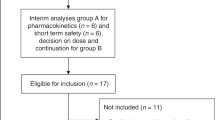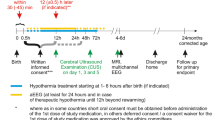Abstract
Aim
The main burden of hypoxic-ischemic encephalopathy falls in low-income countries. 2-Iminobiotin, a selective inhibitor of neuronal and inducible nitric oxide synthase, has been shown to be safe and effective in preclinical studies of birth asphyxia. Recently, safety and pharmacokinetics of 2-iminobiotin treatment on top of hypothermia has been described. Since logistics and the standard of medical care are very different in low-resource settings, the aim of this study was to investigate safety and pharmacokinetics of Two-IminoBiotin in the Democratic Republic of Congo (TIBC).
Methods
Near-term neonates, born in Kinshasa, Democratic Republic of Congo, with a Thompson score ≥ 7 were eligible for inclusion. Excluded were patients with (1) inability to insert an umbilical venous catheter for administration of the study drug; (2) major congenital or chromosomal abnormalities; (3) birth weight < 1800 g; (4) clear signs of infection; and (5) moribund patients. Neonates received six infusions of 2-iminobiotin 0.16 mg/kg started within 6 h after birth, with 4-h intervals, targeting an AUC0–4h of 365 ng*h/mL. Safety, defined as vital signs, the need for clinical intervention after administration of study drug, occurrence of (serious) adverse events, and pharmacokinetics were assessed.
Results
After parental consent, seven patients were included with a median Thompson score of 10 (range 8–16). No relevant changes in vital signs were observed over time. There was no need for clinical intervention due to administration of study drug. Three patients died, two after completing the study protocol, one was moribund at inclusion and should not have been included. Pharmacokinetic data of 2-iminobiotin were best described using a two-compartment model. Median AUC0–4h was 664 ng*h/mL (range 414–917). No safety issues attributed to the administration of 2-iminobiotin were found.
Conclusion
The present dosing regimen resulted in higher AUCs than targeted, necessitating a change in the dose regimen in future efficacy trials. No adverse effects that could be attributed to the use of 2-iminobiotin were observed.
EudraCT number 2015-003063-12.



Similar content being viewed by others
References
United Nations Inter-agency Group for Child Mortality Estimation. In: Levels and trends in child mortality. Report 2018. https://data.unicef.org/wp-content/uploads/2018/10/Child-Mortality-Report-2018.pdf. Accessed 13 Nov 2019.
Lawn JE, Gravett MG, Nunes TM, Rubens CE, Stanton C, Group GR. Global report on preterm birth and stillbirth (1 of 7): definitions, description of the burden and opportunities to improve data. BMC Pregnancy Childbirth. 2010;10(Suppl 1):S1.
Pauliah SS, Shankaran S, Wade A, Cady EB, Thayyil S. Therapeutic hypothermia for neonatal encephalopathy in low- and middle-income countries: a systematic review and meta-analysis. PLoS One. 2013;8(3):e58834.
Albrecht M, Zitta K, Groenendaal F, van Bel F, Peeters-Scholte C. Neuroprotective strategies following perinatal hypoxia-ischemia: taking aim at NOS. Free Radic Biol Med. 2019;142:123–31.
Peeters-Scholte C, Koster J, Veldhuis W, van den Tweel E, Zhu C, Kops N, et al. Neuroprotection by selective nitric oxide synthase inhibition at 24 hours after perinatal hypoxia-ischemia. Stroke. 2002;33(9):2304–10.
Bjorkman ST, Ireland Z, Fan X, van der Wal WM, Roes KC, Colditz PB, et al. Short-term dose-response characteristics of 2-iminobiotin immediately postinsult in the neonatal piglet after hypoxia-ischemia. Stroke. 2013;44(3):809–11.
van den Tweel ER, van Bel F, Kavelaars A, Peeters-Scholte CM, Haumann J, Nijboer CH, et al. Long-term neuroprotection with 2-iminobiotin, an inhibitor of neuronal and inducible nitric oxide synthase, after cerebral hypoxia-ischemia in neonatal rats. J Cereb Blood Flow Metab. 2005;25(1):67–74.
Nijboer CH, Groenendaal F, Kavelaars A, Hagberg HH, van Bel F, Heijnen CJ. Gender-specific neuroprotection by 2-iminobiotin after hypoxia-ischemia in the neonatal rat via a nitric oxide independent pathway. J Cereb Blood Flow Metab. 2007;27(2):282–92.
Neurophyxia. In: Literature: phase 1 clinical study: first-in-man 2-IB dose escalation study. https://www.neurophyxia.com/files/results-phase1-clinical-trial.pdf. Accessed 13 Nov 2019.
Neurophyxia. In: Literature: determination of target dose for phase II study of 2-iminobiotin (2-IB) in neonates with perinatal asphyxia. https://www.neurophyxia.com/files/2012-01-18-Determination-of-target-dose-for-Phase-II.pdf. Accessed 13 Nov 2019.
https://www.clinicaltrialsregister.eu. Accessed 13 Nov 2019. Eudra CT number 2011-002502-74.
Holford N, Heo Y-A, Anderson B. A pharmacokinetic standard for babies and adults. J Pharm Sci. 2013;102:2941–52.
Favié LMA, Peeters-Scholte CMPCD, Bakker A, Tjabbes H, Egberts TCG, van Bel F, Rademaker CMA, Vis P, Groenendaal F. Pharmacokinetics and short-term safety of the selective NOS inhibitor 2-iminobiotin in asphyxiated neonates treated with therapeutic hypothermia. Pediatr Res. 2019. https://doi.org/10.1038/s41390-019-0587-1.
Thompson CM, Puterman AS, Linley LL, Hann FM, van der Elst CW, Molteno CD, Malan AF. The value of a scoring system for hypoxic ischaemic encephalopathy in predicting neurodevelopmental outcome. Acta Paediatr. 1997;86:757–61.
Beal S, Sheiner LB, Boeckmann A, Bauer RJ. NONMEM user’s guides (1989–2011). Ellicott City: Icon Development Solutions; 2011.
Hellström-Westas L, Rosén I. Continuous brain-function monitoring: state of the art in clinical practice. Semin Fetal Neonatal Med. 2006;11(6):503–11.
Hellström-Westas L. Amplitude-integrated electroencephalography for seizure detection in newborn infants. Semin Fetal Neonatal Med. 2018;23(3):175–82.
Biselele T, Bambi J, Naulaers G, Tabu G, Kapinga J, Bola V, et al. Observational study shows that it is feasible to provide neuroprotective treatment for neonatal encephalopathy in low-income countries. Acta Paediatr. 2018;107(8):1345–9.
Jacobs SE, Berg M, Hunt R, Tarnow-Mordi WO, Inder TE, Davis PG. Cooling for newborns with hypoxic ischaemic encephalopathy. Cochrane Database Syst Rev. 2013;1:CD003311.
Montaldo P, Pauliah SS, Lally PJ, Olson L, Thayyil S. Cooling in a low-resource environment: lost in translation. Semin Fetal Neonatal Med. 2015;20(2):72–9.
IHME. Global burden of disease. https://vizhub.healthdata.org/gbd-compare/. Accessed 7 Nov 2019.
Acknowledgements
We greatly thank Laurent Favié and Floris Groenendaal, the investigators of the 2-STEP study, who included patients in the 2-STEP study and provided PK data of patients from Group A to enrich the PK population model.
Author information
Authors and Affiliations
Corresponding author
Ethics declarations
Funding
This study was funded by Neurophyxia BV.
Conflict of interest
Authors T. Biselele, J. Bambi, D. Betukumesu, Y. Ndiyo, G. Tabu, J. Kapinga, V. Bola, P. Makaya, and P. Vis have no disclosures. Authors H. Tjabbes and C. Peeters-Scholte are co-founders, consultants for and shareholder of Neurophyxia BV. Author H. Tjabbes is Vice-President Regulatory and Medical Affairs of Neurophyxia, and author C. Peeters-Scholte is Chief Scientific Officer.
Informed consent
All procedures performed in studies involving human participants were in accordance with the ethical standards of the ethical committee of the Public Health School of the University of Kinshasa (DR Congo) and the ethical committee of the University of Utrecht (The Netherlands), and in line with the 1964 Helsinki declaration and its later amendments or comparable ethical standards. Written informed consent was obtained from one of the parents in local language (Lingala) or French before start of the study. When the consenting parent was illiterate, informed consent was given verbally in the presence of an impartial witness.
Electronic supplementary material
Below is the link to the electronic supplementary material.
Rights and permissions
About this article
Cite this article
Biselele, T., Bambi, J., Betukumesu, D.M. et al. A Phase IIa Clinical Trial of 2-Iminobiotin for the Treatment of Birth Asphyxia in DR Congo, a Low-Income Country. Pediatr Drugs 22, 95–104 (2020). https://doi.org/10.1007/s40272-019-00373-3
Published:
Issue Date:
DOI: https://doi.org/10.1007/s40272-019-00373-3




